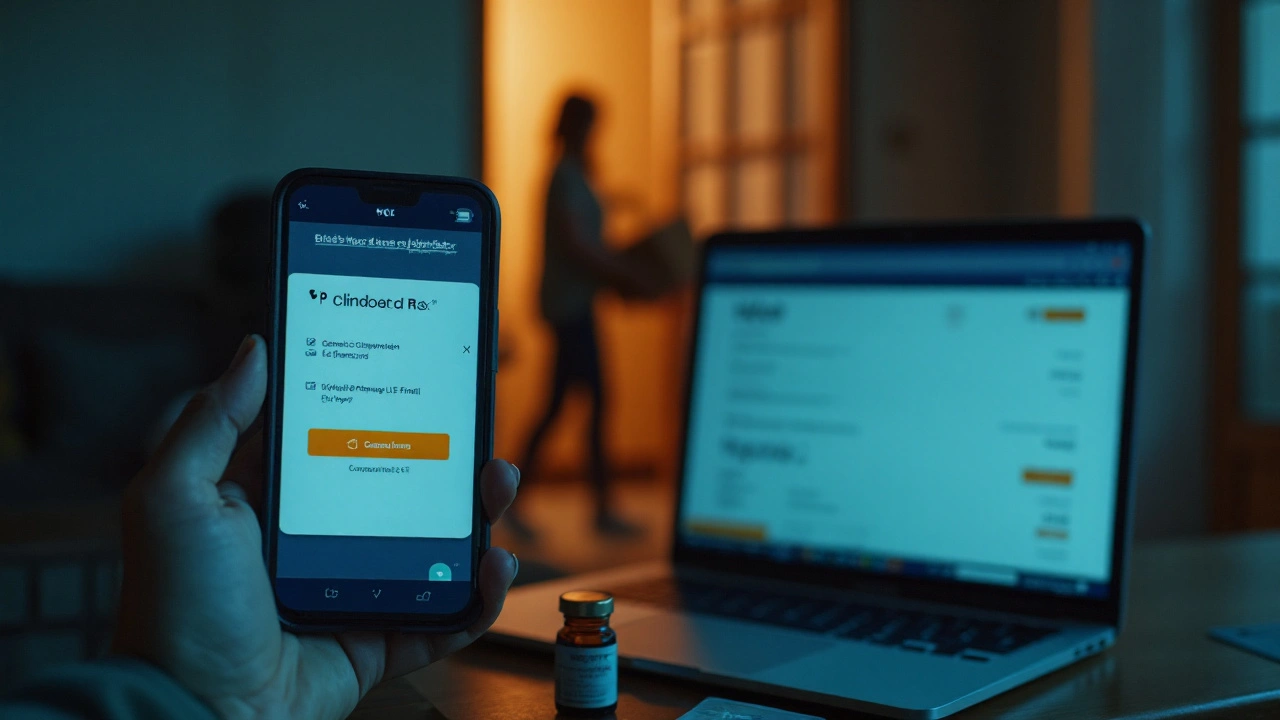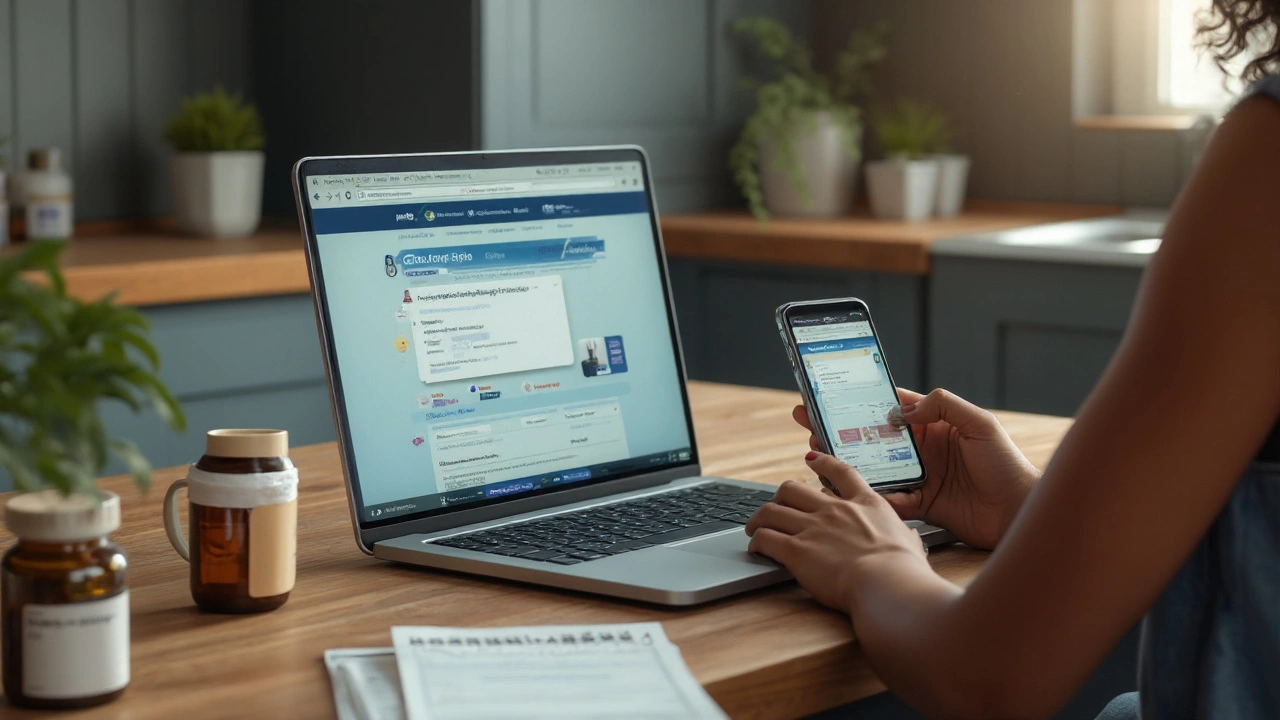You want to buy clindamycin without getting scammed or overpaying. The catch? It’s a prescription antibiotic, counterfeits are common online, and prices jump wildly between pharmacies. Here’s the straight path: what you’re actually buying, how much you should expect to pay in 2025, how to spot a legit pharmacy fast, which form (capsule, gel, vaginal) fits your need, and the exact steps to place a safe order today.
What you likely want to accomplish right now: find a reliable site that requires your prescription, lock in a low price, understand the differences between oral and topical versions, avoid fake meds, and get your treatment delivered on time. I’ll keep it simple, specific, and practical so you can check those boxes in one sitting.
What You’re Buying: Generic Clindamycin, Forms, and When It’s Used
Clindamycin is a lincosamide antibiotic that slows or stops the growth of certain bacteria. The brand name many people know is Cleocin, but the generic (just called clindamycin) is the same active ingredient and is usually far cheaper. It treats bacterial infections; it won’t help viral illnesses like colds or flu. Using it properly matters. Misuse fuels antibiotic resistance and can lead to serious side effects.
A quick map of the common prescription forms you’ll see online:
- Oral capsules/tablets (most common for systemic infections) - typical strengths you’ll see listed: 75 mg, 150 mg, 300 mg.
- Oral solution (for those who can’t swallow capsules).
- Topical clindamycin (usually 1% gel, solution, or lotion) - often used for acne, applied to the skin.
- Vaginal clindamycin (cream 2% or ovules) - for certain vaginal infections as diagnosed by a clinician.
- Injection - hospital/clinic setting; you won’t order this online.
Oral clindamycin reaches the whole body and is used for skin/soft tissue infections, dental infections, and some bone/joint infections when appropriate. Topical clindamycin stays mostly where you put it and is used for acne; vaginal forms act locally for diagnosed bacterial conditions. Your prescriber chooses the form, strength, and duration. Stick to that plan; don’t improvise.
Safety signals you should know before you buy:
- FDA boxed warning: clindamycin can cause severe diarrhea, including Clostridioides difficile-associated diarrhea (CDAD). If you develop watery or bloody diarrhea, contact your clinician urgently. Source: FDA Prescribing Information (2024 update).
- Allergy risk: hives, swelling, trouble breathing → emergency care.
- Drug interactions: may interact with warfarin (can affect INR), erythromycin (antagonism), and neuromuscular blockers. Tell your prescriber and pharmacist about everything you take, including supplements. Source: FDA label.
- Liver considerations: clindamycin is metabolized in the liver; dosing may need monitoring in hepatic impairment. Your prescriber will manage this.
Bottom line: you need a valid prescription for systemic clindamycin and, ideally, for topical/vaginal forms too. Buying from a site that ships antibiotics with “no prescription needed” is a hard stop. It’s not just a legal problem; it’s a safety risk.
Real-World Prices in 2025 and How to Pay Less
Prices move week to week and vary by pharmacy, city, and whether you use a coupon or your insurance. Here’s what typical U.S. cash prices (no insurance) look like in mid-2025, based on public coupon aggregators and large chain cash pricing:
- Clindamycin capsules (300 mg): roughly $12-$45 for 20-30 capsules with a coupon; $70-$150 without. Prices swing by region.
- Clindamycin capsules (150 mg): often a bit cheaper per bottle than 300 mg, but check the per-mg cost.
- Topical clindamycin 1% gel, 30 g: about $10-$35 generic with a coupon; $40-$80 without.
- Vaginal clindamycin cream 2% (one 40 g tube): commonly $20-$60 with a coupon; $60-$120 without.
Use this quick rule: compare by unit price, not just the bottle price.
- Unit price per dose = total price ÷ number of doses. For capsules, that’s price per capsule; for topical, price per gram.
- If you’re comparing 150 mg vs 300 mg capsules, normalize to price per 300 mg to see the true difference.
Shipping: reputable U.S. online pharmacies typically charge $0-$5 for standard shipping (2-7 business days), with expedited options in the $10-$20 range. Some offer free shipping above a small minimum. If a site insists on international shipping for prescription meds into the U.S., that’s a legal red flag. FDA import rules for personal prescription drug shipments are strict; stick with licensed U.S. pharmacies for prescription antibiotics. Source: FDA BeSafeRx.
How to pay less without cutting corners:
- Stack a free pharmacy coupon with your cash price. Major coupon platforms often beat insurance copays for generics.
- Ask your prescriber if a different strength or quantity reduces cost per dose (same total therapy, lower price per mg).
- Use pharmacy price-matching policies when available; some chains will match a local competitor’s coupon price.
- Mail-order through your insurer can be cheaper for 90-day maintenance meds; for short antibiotic courses, compare cash coupon prices first.
- HSA/FSA cards usually work for prescription purchases.
Payment methods a legit site will accept: major credit/debit cards, sometimes HSA/FSA cards. Red flags: cryptocurrency only, wire transfers, gift cards, or requests to pay via social apps with no receipt. Keep your invoice; it’s useful if there’s a problem or recall.

Safety First: How to Choose a Legit Online Pharmacy
Here’s a fast checklist that catches most bad actors. If a site fails any one of these, walk away.
- Requires a valid prescription from your clinician (or offers a lawful telehealth visit with licensed U.S. clinicians).
- Shows its U.S. pharmacy license and physical location, plus a phone number to reach a pharmacist.
- Holds NABP Digital Pharmacy Accreditation or lists state licenses you can verify. Source: National Association of Boards of Pharmacy (NABP).
- Has a clear, reasonable privacy policy and doesn’t sell your health data.
- Sends medications in tamper-evident, child-resistant packaging with proper labeling.
Classic red flags of a rogue pharmacy:
- “No prescription needed” for antibiotics or other Rx meds.
- Prices that are unbelievably low compared with multiple reputable sources.
- No U.S. license details, no pharmacist contact, or vague contact info.
- Bulk sales of antibiotics “for any infection.” That’s not how responsible pharmacies operate.
- Pushy emails/texts or claims like “miracle cure.”
Quality and authenticity guardrails:
- Look for FDA-approved generics made by established manufacturers (your pharmacy can tell you the labeler name).
- Check the pill/gel against images and descriptions in the packaging insert. If it looks wrong or labeling is missing, contact the pharmacy before using it.
- If you suspect a problem, report to FDA MedWatch and notify your prescriber.
Why this matters: the FDA’s BeSafeRx and recent NABP reports continue to find large numbers of illegal online pharmacies that sell substandard or counterfeit drugs. Antibiotics are a common target because demand is steady. Taking a counterfeit antibiotic risks treatment failure and serious complications.
Your Options Compared: Forms, Brands, and Where to Buy
Use this to match your situation with the smartest purchase path. Always align with what your prescription says; don’t swap forms on your own.
| Option | Best For | Pros | Cons |
|---|---|---|---|
| Generic clindamycin oral capsules | Systemic infections (as prescribed) | Low cost; wide availability; same active as brand | Higher risk of GI side effects; boxed warning for severe diarrhea |
| Generic clindamycin 1% topical (gel/lotion/solution) | Acne (as prescribed) | Acts locally; fewer systemic effects | Skin irritation possible; add-on treatments may still be needed |
| Generic clindamycin vaginal (2% cream or ovules) | Diagnosed vaginal bacterial infections | Local treatment; short courses | Messy application; not for all types of vaginitis |
| Brand (e.g., Cleocin, Clindagel) | When insurer requires brand or patient prefers | Same efficacy; sometimes specific device/form | Usually higher price with no added benefit |
| Online pharmacy (U.S.-licensed) | Convenience; privacy; price shopping | Home delivery; easy coupon use; low overhead pricing | Shipping time; must verify legitimacy |
| Local pharmacy | Urgent fills; face-to-face counsel | Immediate pickup; easy problem solving | Sticker shock if you forget to use a coupon |
Not sure whether generic equals brand in your case? For clindamycin, the FDA requires generics to meet the same quality and performance standards as the brand. For most people, generic is the value play.
When online makes sense:
- You don’t need the medication this hour and can wait 2-5 days.
- You have time to compare prices and want doorstep delivery.
- You’re ordering a topical or a short course and found a verified low price.
When local wins:
- You need the first dose today.
- You want in-person counseling for a complex medication list.
- Your prescriber sent an e-prescription to a nearby chain that can fill it immediately.

Order the Right Way Today: Step-by-Step, FAQs, Next Steps
If you’re ready to buy generic clindamycin online, use this simple workflow so you save money without cutting safety corners.
- Confirm the prescription details: medication name (clindamycin), form (capsule, gel, cream), strength, quantity, and duration. If anything is unclear, ask your prescriber.
- Pick a legitimate pharmacy: verify state licenses and, ideally, NABP Digital Pharmacy Accreditation. Make sure they require your prescription and offer pharmacist support.
- Compare prices the right way: check at least three reputable sites, calculate unit price (per capsule or per gram), and factor in shipping time and cost.
- Upload or send the prescription: follow the site’s instructions for e-prescribe, upload, or fax. Don’t use any site that offers to “create” a prescription without a real clinical visit.
- Check the final cart: correct strength, quantity, generic manufacturer (if listed), shipping speed, and total cost with coupon. Save a screenshot.
- Place the order with a traceable payment method: credit/debit or HSA/FSA. Keep the receipt, order number, and expected delivery date.
- On delivery: verify the label (your name, drug, strength, directions), check the manufacturer and lot number, and inspect packaging for tampering.
- Use exactly as prescribed: don’t skip doses, don’t double up without guidance, and finish the course unless your clinician says to stop.
- Watch for side effects: mild stomach upset can happen. Severe diarrhea, rash, facial swelling, or breathing issues need prompt medical attention.
- Dispose of leftovers appropriately: antibiotics shouldn’t be saved “just in case.” Ask your pharmacy about take-back programs.
Risks you can neutralize right now:
- Counterfeits → only buy from U.S.-licensed pharmacies that require a prescription; verify license numbers with your state board of pharmacy.
- Data misuse → check the privacy policy; avoid sites that sell or share health data for marketing.
- Delays → choose expedited shipping if your start date is soon; confirm stock before paying.
- Wrong dose/quantity → match your order to the prescription line by line before checkout.
Common side effects and when to call your clinician (from FDA labeling and clinical practice):
- Common: nausea, abdominal pain, mild diarrhea, metallic taste (oral); skin dryness or irritation (topical).
- Serious: severe or persistent diarrhea (possible C. diff), allergic reactions (hives, swelling, difficulty breathing), severe rash, liver issues (dark urine, yellowing of skin/eyes). Seek care immediately for serious symptoms.
Antibiotic stewardship matters: taking antibiotics only when needed and exactly as directed keeps you safer and preserves effectiveness for everyone. See CDC’s Antibiotic Use program for the why and how.
Mini-FAQ
- Do I legally need a prescription in the U.S.? Yes. Reputable pharmacies will require it for all oral clindamycin and typically for topical/vaginal forms as well. Source: FDA/State boards of pharmacy.
- Can I switch from capsules to topical to save money? No. They treat different problems. Only your prescriber can change the form.
- Is generic as good as the brand? Yes. FDA-approved generics must match brand strength, quality, and performance.
- What if the site is much cheaper than everyone else? If it’s dramatically cheaper and skips prescriptions, it’s likely illegal or selling substandard meds. Avoid.
- How long does shipping take? Typical is 2-7 business days in the U.S. Expedited options exist. Confirm stock before paying if timing is tight.
- Can I drink alcohol with clindamycin? Alcohol doesn’t directly interact with clindamycin, but it can worsen stomach upset and dehydration. When sick, skip or limit alcohol.
- Pregnant or breastfeeding? Talk to your prescriber. Clindamycin is used in pregnancy for certain infections when benefits outweigh risks; clinical judgment matters. Source: FDA label.
Next steps / Troubleshooting
- If your insurance copay is higher than cash: compare cash coupon prices for the exact strength and quantity. Ask the pharmacy to run it as cash if it’s cheaper.
- If the pharmacy is out of stock: ask them to transfer the prescription to a nearby pharmacy that has it. Transfers are routine.
- If your order is late: contact the pharmacy with your order number; if you need to start sooner, request a partial local fill while waiting on the shipment.
- If you can’t tolerate side effects: call your prescriber-don’t stop abruptly unless advised. There may be alternatives or supportive measures.
- If the price is still high: ask about a different strength with the same total daily dose that prices better per mg, or a different pharmacy with better contracts.
Credible sources you can trust (no sign-ups or gimmicks): FDA Prescribing Information for clindamycin (2024 update), FDA BeSafeRx on buying safely online, NABP Digital Pharmacy Accreditation listings, and CDC’s Antibiotic Use resources. These are the folks setting the rules and tracking safety. Use them as your north star.
If you do nothing else, do these three things: verify the pharmacy license, compare unit prices across at least three reputable sources, and use clindamycin exactly as prescribed. That’s how you save money and stay safe.



Comments
If you buy clindamycin online, verify the pharmacy license and check the lot number on the bottle before you take a single dose. The chemistry is simple but the market is messy, and that mismatch costs lives when resistance or contamination shows up. Start by confirming a physical address and a pharmacist phone line, then cross-check the state board listing. If a site offers antibiotics with no prescription, treat it as fraudulent and move on quickly. Check the manufacturer name on the label and, if available, compare it to FDA-approved generics lists to rule out obscure overseas labelers. For systemic therapy, matching mg per dose and total daily mg matters more than the brand name jargon people latch onto. Keep a screenshot of the prescription upload and the pharmacy invoice because paperwork helps when something goes wrong. When the package arrives, verify tamper seals and compare pill appearance to reliable images, and do not use anything with mismatched batch numbers or missing labeling. Remember that clindamycin's boxed warning about C. difficile is not trivia, it's a call to be conservative with use. If the course is short and prescribed appropriately, the benefits often outweigh the risks, but that calculus flips if you self-prescribe from a sketchy online vendor. Pharmacies that accept HSA cards and major credit cards are usually operating on transparent rails, unlike those demanding crypto or weird payment channels. Pay attention to unit price per mg, not just sticker shock per bottle, because the arithmetic saves cash without compromising therapy. Use coupons, sure, but avoid coupon-only shops with no verifiable credentials. If you have liver disease or are on warfarin, flag that to the pharmacist early so they can check interactions and monitoring plans. Finally, keep antibiotic stewardship in mind and finish the prescribed course unless your clinician tells you otherwise. Those steps cut both risk and waste in one practical sweep.
Follow the steps, upload the Rx, save the receipt, and call the pharmacist once your order ships.
Solid practical tips and the price ranges line up with what I saw in my area. I always check per-mg math and then call the pharmacy to confirm manufacturer if it's not listed. If they hesitate or dodge that simple question I bounce, because transparency is basic. For topical acne stuff I prefer local pick-up so I can smell and look at the tube, weird but it helps me sleep. Don’t forget to ask about generic equivalence if your insurer balks at the brand name. Keep the packaging until you finish the course, it helps with recalls and returns.
No Rx, no sale - that should be non negotiable, period. If a site hides its license details, it’s sketchy and probably illegal. Also the unit price trick is basic arithmetic, use it. Don’t be lazy and click the cheapest ad without verification.
Too many people equate low price with good value. Low price often equals low oversight. Verify credentials, then decide.
Good points raised here, especially about checking lot numbers and calling the pharmacist. That little extra step saved me from a bad batch once. Stay safe everyone 🙂
People act like the internet is a neutral place where markets simply correct themselves and everything will sort out by supply and demand and then suddenly a vulnerable person ends up with a counterfeit antibiotic that does nothing while the infection gets worse and the entire drama snowballs into a hospital stay with complications and life becomes a nightmare of follow ups and insurance calls and blame and regret and I refuse to gloss over that reality. This isn't theoretical theatre, it's lived consequences for folks who just needed straightforward care but trusted the wrong seller because the price looked irresistible and the site had slick marketing. You have to be obsessively cautious now, not casually optimistic, because the stakes are not your social media clout but your gut flora and resistance profiles and potential C. diff nightmare. Keep receipts, insist on seeing the labeler name, compare lot numbers, and if anything smells off or the packaging is amateurish, throw it in a secure disposal bin and do not use it. The FDA and NABP warnings exist for a reason, they’re not bureaucracy for its own sake. Also nobody should accept a vendor that asks for Bitcoin or weird payment channels, that’s intentionally opaque and undermines accountability. Keep a paper trail, screenshot the pharmacy license, photocopy the prescription if you must, and store the order emails in a folder so you can forward them if the need arises. If you’re on other meds, list everything on the prescription upload and have the pharmacist confirm interactions instead of playing Russian roulette. Visual verification on arrival is crucial, compare pills to photos from legitimate sources and check for spelling errors on labels which is a classic counterfeit sign. Use coupon platforms but never at the cost of skipping verification, because scammers mimic coupon codes to lure buyers into trusting them. If you’ve had previous bad reactions or issues, note that on the order and call the pharmacy before they send anything so you get a pharmacist note on the record. Don’t be shy about asking for the manufacturer’s lot and expiration and do not accept evasive answers, that’s an immediate red flag. Keep emergency numbers at hand and know what constitutes severe side effects so you act fast - time matters with CDAD and severe allergic reactions. The last thing you want is to be bargaining over return shipping while your condition worsens; prevent that by being methodical upfront. In short, pragmatic paranoia and paperwork will protect you more than wishful thinking ever will
All sound advice, especially not trusting ‘no Rx needed’ sites. If it’s legit it won’t vanish when you try to verify it. Keep receipts, check labels, and be calm about it. It’s not worth the risk to shortcut this one.